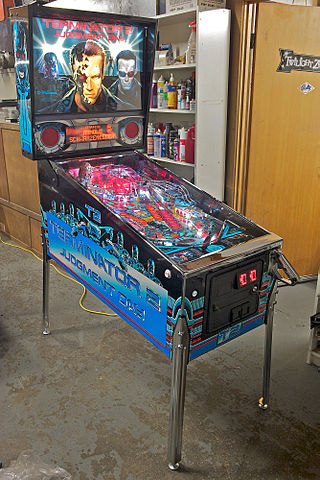
Pinball games are a family of games in which a ball is propelled into a specially designed table where it bounces off various obstacles, scoring points either en route or when it comes to rest. Historically the board was studded with nails called 'pins' and had hollows or pockets which scored points if the ball came to rest in them. Today, pinball is most commonly an arcade game in which the ball is fired into a specially designed cabinet known as a pinball machine, hitting various lights, bumpers, ramps, and other targets depending on its design. The game's object is generally to score as many points as possible by hitting these targets and making various shots with flippers before the ball is lost. Most pinball machines use one ball per turn, and the game ends when the ball(s) from the last turn are lost. The biggest pinball machine manufacturers historically include Bally Manufacturing, Gottlieb, Williams Electronics and Stern Pinball.
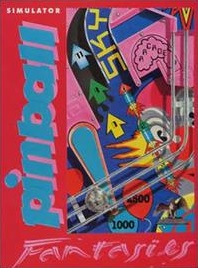
Pinball Fantasies is a 1992 pinball video game originally developed by Digital Illusions and published by 21st Century Entertainment in Europe for the Amiga home computers. It is the sequel to Pinball Dreams, which was released earlier in the same year on multiple platforms. In the game, players can choose between any of the four available playfields, both of which have their own thematic and main objectives in order to obtain the highest score possible.
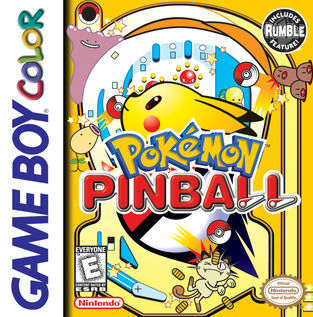
Pokémon Pinball is a pinball-based Pokémon spin-off video game for the Game Boy Color. It was released in Japan on April 14, 1999, and in North America on June 29, 1999. In it, the ball is a Poké Ball, and most of the objects on the table are Pokémon-related.

Pokémon Pinball: Ruby & Sapphire is a 2003 pinball game developed by Jupiter and published by The Pokémon Company and Nintendo for the Game Boy Advance handheld game console. It was first revealed at E3 2003. The North American release was done to coincide with the fifth anniversary of the North American release of Pokémon Red and Blue. It is based on Pokémon Ruby and Sapphire, and is a sequel to Pokémon Pinball for the Game Boy Color. In some ways, it plays like a traditional pinball game, where the objective is to get a high score by keeping the ball in play as long as possible and hitting bumpers. In keeping with the theme of Pokémon, it features Pokémon collection, where while the players play pinball, they must also capture the eponymous creatures.
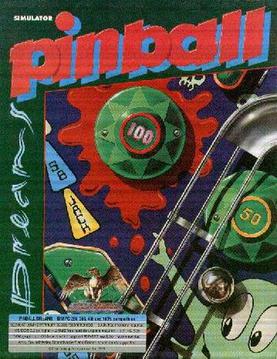
Pinball Dreams is a pinball simulation video game developed by Digital Illusions and originally released for the Amiga in 1992. It spawned several sequels, including Pinball Fantasies and Pinball Illusions. The MS-DOS port was digitally released by Rebellion Developments along with its sequel and Pinball Mania on February 22, 2011 on GOG.com with support for Microsoft Windows. It received an OS X build on April 23, 2013; and a Linux build on August 19, 2014.
A glossary of terms, commonly used in discussing pinball machines.

Psycho Pinball is a 1994 pinball video game published and developed by Codemasters, released for Mega Drive in the United Kingdom and MS-DOS in the United States and Europe.
3-D Ultra Pinball is a series of pinball computer games developed by Sierra Entertainment's Dynamix. The games try to escape from the traditional, arcade pinball and feature animation, more than one table at once, and "temporary targets".

Pro Pinball: Big Race USA is an action video game developed by Cunning Developments, published by Empire Interactive and distributed by Take-Two Interactive for Microsoft Windows and PlayStation. It is the third game in the Pro Pinball series, and is themed around travelling around the United States in a car, similar to the Williams physical table Red & Ted's Road Show.

Addiction Pinball is a pinball video game developed by Team17 and published by MicroProse for Microsoft Windows in 1998. It features tables based on two Team17 games, World Rally Fever and Worms.

Black Knight is a 1980 pinball machine designed by Steve Ritchie and released by Williams Electronics. Ritchie designed two sequels: Black Knight 2000, released by Williams in 1989, and Black Knight: Sword of Rage, released by Stern Pinball in 2019.

Pinball FX is a pinball machine video game for the Xbox 360. It was developed by Zen Studios and published by Microsoft Game Studios. It was released on April 25, 2007 via the Xbox Live Arcade service. The game features three tables, with six more available as downloadable content, leaderboards and online multiplayer. A sequel to the game, Pinball FX 2 was released on October 27, 2010.

Zen Pinball is a series of pinball machine video games developed and published by Zen Studios. It was originally released on iOS as two separate applications, each containing one table; Zen Pinball: Rollercoaster, released July 7, 2008, and Zen Pinball: Inferno, released October 31, 2008. Zen Pinball for the PlayStation 3 features four tables, plus an additional six tables as downloadable content. It was released on the PlayStation Network on May 14, 2009. It is the non-Microsoft counterpart to the Pinball FX series on the Xbox 360, and the first pinball game on the PlayStation 3. The game was also released on Android devices as Zen Pinball THD on December 1, 2011, and the Nintendo 3DS as Zen Pinball 3D via the Nintendo eShop on December 1, 2011 in Europe and January 12, 2012 in North America.

Star Trek Pinball is a pinball video game based on the Star Trek franchise, developed by Sales Curve Interactive and published by Interplay for DOS in 1998. It could be purchased by itself or bundled with Starfleet Academy.

Dream Pinball 3D is a pinball simulation game developed by TopWare Interactive and published by SouthPeak Games for Microsoft Windows, first released online in 2006, and then ported to Wii and Nintendo DS in 2008. Dream Pinball 3D features six tables to play on, each with a distinct theme, including a medieval table, an aquatic table, a monsters table, and a dinosaurs table. Apart from the different visual styles, each of these tables pose a different challenge because of their varying flipper, ramp, and bumper positions.

Marvel Pinball is a 2010 pinball video game developed by Zen Studios. It features Marvel Comics-themed pinball tables. It is available as a standalone game for the PlayStation 3 via the PlayStation Network, and as downloadable content for Pinball FX 2 on the Xbox 360 via Xbox Live Arcade. Its content on the PlayStation 3 is also playable in Zen Pinball 2. It is the second pinball title for the PlayStation 3, succeeding Zen Pinball. It was released on December 8, 2010, on the Xbox 360 and December 14, 2010, on the PlayStation 3.

The Pinball Arcade is a pinball video game developed by FarSight Studios. The game is a simulated collection of 100 real pinball tables licensed by Gottlieb, Alvin G. and Company, and Stern Pinball, a company which also owns the rights of machines from Data East and Sega Pinball. Williams and Bally games are no longer available since June 30, 2018, as FarSight had lost the license to WMS properties, which has since passed to Zen Studios.

Pro Pinball: Fantastic Journey is an action video game developed by Cunning Developments, published by Empire Interactive and distributed by Take-Two Interactive for Microsoft Windows and PlayStation. It is the fourth game in the Pro Pinball series. Elements of the game include combinations of Victorian era settings, steam powered machinery, steampunk style nautical adventures, and fictional islands.
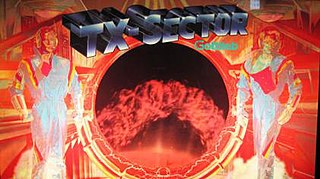
TX-Sector is a pinball machine designed by John Trudeau and released by Gottlieb in 1988. The game features a scifi theme and revolves around raising the energy level to teleport the ball.

3-D Ultra Pinball: Thrillride is a 2000 pinball game developed for Windows and Macintosh by Dynamix Inc. and for the Game Boy Color by Left Field Productions, and published by Sierra On-Line. The game is part of the 3-D Ultra Pinball series of pinball games.


















